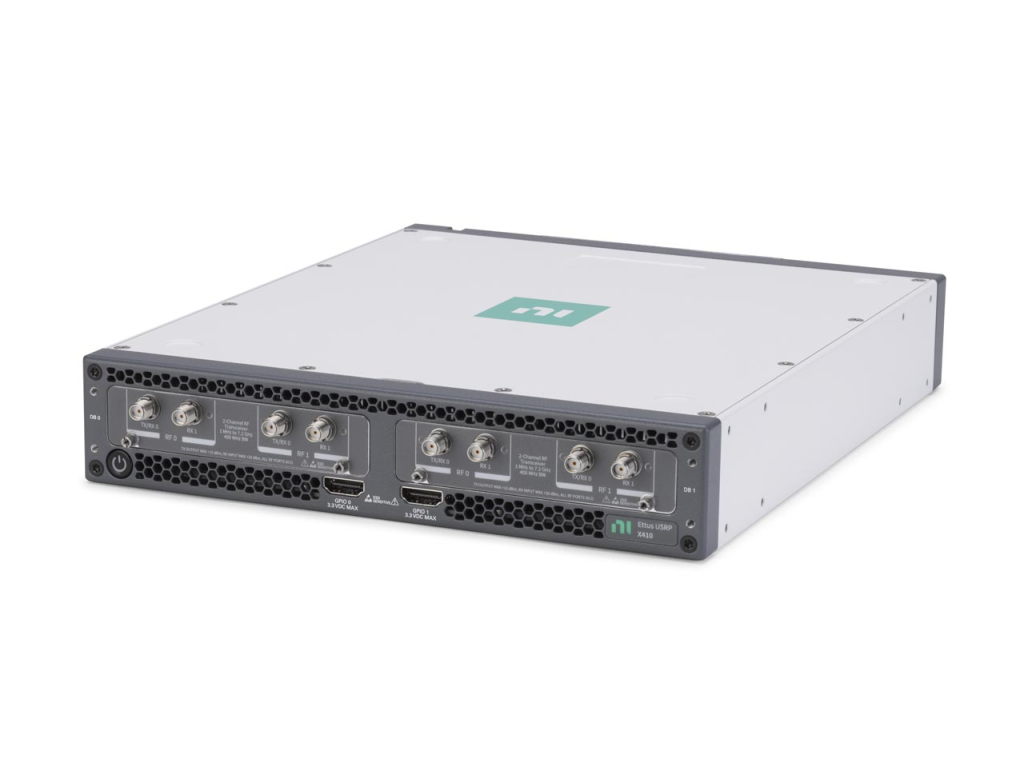您的购物车目前是空的!
标签: USRP X410
-
招标技术参数:软件无线电 X410
一、范围
本文件规定了软件无线电开发装置采购的标准技术参数、使用环境条件、组件材料配置的项目需求及投标人响应等要求。本文件适用于软件无线电开发装置采购。
二、标准技术参数
技术参数特性表是XXX对采购设备的基础技术参数要求,在招投标过程中,投标人应该依据招标文件,对技术参数特性表中标准参数值进行响应,详见表1。
序号 技术参数名称 单位 项目需求值或表述 投标人响应值 1 软件无线电装置主体 1.1 射频性能 / 4发4收,独立可调制。1 MHz到7.2 GHz,最高课调整至8 GHz 每通道不小于 400 MHz 带宽 1.2 处理系统 / 四核 ARM Cortex-A53(1200 MHz)
4 GB DDR41.3 可编程逻辑单元 / FPGA: RFSoC ZU28DR 2 × 4 GB DDR4 1.4 适配软件 / UHD version 4.1 or later RFNoC GNU Radio C/C++ Python OpenEmbedded Linux on A53 NI-USRP 20.8 or later LabVIEW 2020 or later LabVIEW FPGA 2020 or later Matlab R2022a 1.5 时钟同步方式 / REF IN (clock reference input) PPS IN (PPS time reference) TRIG IN/OUT GPSDO included OCXO included 1.6 数字接口 / 2 QSFP28 (10/100 GbE, Aurora) 2 iPass+ zHD (cabled PCIe Gen3 x8)[2] Ethernet (1 GbE to PS) 2 USB-C (USB to PS, Console/JTAG) 2 HDMI (GPIO) 1.7 输入电源 / 12 V DC, 16 A 最大 1.8 尺寸体积 / 不大于29cm × 23 cm × 5cm 1.9 ADC分辨率 / 12 bit 1.10 DAC分辨率 / 14 bit 1.11 频率步进 / <1 Hz 1.12 RF最大输出功率 / 不小于23 dBm 1.13 频率准确度 / OCXO (未锁定GPS) 2.5 ppm OCXO (GPS驯服状态) 5 ppb -
USRP X410
787272-01 | USRP X410 (4 TX/RX Channels, 400 MHz BW, Zynq US+ RFSoC ZU28DR) $ 29,950.00 USD
The NI Ettus USRP X410 is a high-performance, multi-channel, Zynq US+ RFSoC based software defined radio (SDR) for designing and deploying next generation wireless systems.

Overview
The NI Ettus USRP X410 is a high-performance, multi-channel software-defined radio. The SDR is designed for frequencies from 1 MHz to 7.2 GHz, tunable up to 8 GHz and features a two-stage superheterodyne architecture with 4 independent TX and RX channels capable of 400 MHz of instantaneous bandwidth each. Digital interfaces for data offload and control include two QSFP28 interfaces capable of 100 GbE, a PCIe Gen3 x8 [1] interface, as well standard command, control, and debug interfaces: USB-C JTAG, USB-C console, Ethernet 10/100/1000. The USRP X410 is an all-in-one device built on the Xilinx Zynq Ultrascale+ ZU28DR RF System on Chip (RFSoC) with built-in digital up and down conversion and onboard Soft-Decision Forward Error Correction (SD-FEC) IP.
Use the software of your choice
The NI Ettus USRP X410 is fully supported on the popular open-source USRP Hardware Driver (UHD) version 4.1 or later[2]. UHD 4.1 was designed to support the large data movement requirements imposed by the 400 MHz bandwidth and multiple channels onboard. The USRP X410 supports open-source SDR design flows such as C/C++ and GNU Radio, as well as LabVIEW FPGA [1]. Unlike other RFSoC-based systems, the USRP X410 is fully ready to port your previous UHD designs to take advantage of high-performance capabilities with a simple recompile.Networked / Stand-Alone Operation
Since the USRP X410 is built on the ZU28DR RF System on Chip (RFSoC) device, it comes equipped with a quad-core ARM Cortex-A53 processing subsystem, clocked up to 1.2 GHz for stand-alone application requirements. Additionally, the RFSoC contains a dual-core ARM Cortex-R5 real-time processing unit for onboard monitoring and control.Built-In IP
The onboard RFSoC on the USRP X410 contains more than twice the FPGA programmable logic resources than that of the previous generation X-series USRP devices. In addition, the ZU28DR comes with 8 soft-decision forward error correction (SD-FEC) hard IP cores, ideal for wireless communication systems. Given the high-speed nature of the built-in ADCs and DACs to the RFSoC, the Zynq device has 8 digital upconversion and digital down-conversion IP cores allowing for rapid in-band retuning or signal reduction.Multi-Radio Synchronization
Multi-radio clocking and timing synchronized operation is possible with the built-in GPSDO (GPS disciplined oscillator) or with the 10 MHz reference and 1 PPS (Pulse Per Second) input signal interfaces. Multi-Radio phase-aligned and phase-coherent operations are not supported, as RF chain LO import and export functionality is not supported on the USRP X410.[1] PCIe Gen3 x8 is only supported by NI-USRP and LabVIEW FPGA design flows
[2] 100 GBE supported in UHD 4.2 or laterFeatures
- High channel density
- Reliable and fault-tolerant deployment
- Stand-alone (embedded) or host-based (network streaming) operation
- Fully integrated and assembled (the USRP X410 does not support swappable daughtercards)
- 1 MHz to 7.2 GHz frequency range (tunable up to 8GHz)
- Up to 400 MHz of instantaneous bandwidth per channel
- 4 RX, 4 TX in half-wide RU form factor
- Xilinx Zynq-Ultrascale+ ZU28DR RFSoC
- 12 bit ADC, 14 bit DAC
- IQ Sample Clock rates up to 500 MS/s
- Onboard SD-FEC, DDC, DUC
- Quad-core ARM Cortex-A53 up to 1.2 GHz CPU
- Dual-core ARM Cortex-A5 MPCore up to 500 MHz
- Two QSFP28 ports (10 Gigabit Ethernet, 100 Gigabit Ethernet, Aurora)
- Two iPass+™ zHD® Interfaces (PCIe Gen3 x 8)
- RJ45 (1 GbE) [1]
- 10 MHz Clock reference
- PPS time reference
- Trig In/Out Interface
- Built-in GPSDO
- Two FPGA Programmable GPIO Interfaces (HDMI)
- 1 Type C USB host port
- 1 Type C USB port (serial console, JTAG)
- Watchdog timer
- OpenEmbedded Linux
- USRP Hardware Driver™ (UHD) open-source software API version 4.1.0 or later
- RF Network on Chip (RFNoC™) FPGA development framework
- Xilinx Vivado® 2019.1 Design Suite (license not included)
- GNU Radio support is maintained by Ettus Research™ through GR-UHD, an interface to UHD distributed by GNU Radio
[1] The RJ45 port is used for remote management of the device and does not support IQ streaming.
Additional Resources
Kit Contents
- USRP X410
- RJ45 Ethernet Cable
- USB-C to USB-A cable
- Power Supply
Quotes and Sales
Email:sales@tekdf.com
Wechat:dftech_info